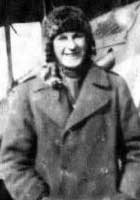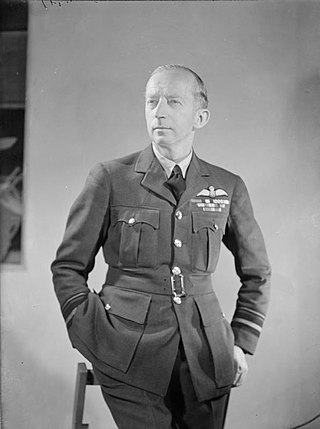Related Research Articles

Air Marshal Robert Leckie, was an air officer in the Royal Air Force and later in the Royal Canadian Air Force, and served as Chief of the Air Staff of the Royal Canadian Air Force from 1944 to 1947. He initially served in the Royal Naval Air Service during the First World War, where he became known as one of "the Zeppelin killers from Canada", after shooting down two airships. During the inter-war period he served as a Royal Air Force squadron and station commander, eventually becoming the RAF's Director of Training in 1935, and was Air Officer Commanding RAF Mediterranean from 1938 until after the beginning of the Second World War. In 1940 he returned to Canada where he was primarily responsible for the British Commonwealth Air Training Plan, transferring to the Royal Canadian Air Force in 1942.
Group Captain Horace Percy Lale was a Royal Air Force officer and British World War I flying ace credited with 23 victories.
Group Captain Harold Alfred Whistler, was an English fighter pilot and flying ace in the First World War.

Wing Commander William Mayes Fry was a World War I Royal Flying Corps and Royal Air Force fighter ace. He was credited with eleven aerial victories, piloting no fewer than four different types of fighter aircraft. Fry also has the distinction of being one of the few World War I airmen to survive to the 1990s.
Air Vice Marshal Eric Bourne Coulter Betts, was an Irish air officer of the British Royal Air Force. He began his career in the Royal Naval Air Service during the First World War. He became a flying ace credited with six aerial victories, although acedom was incidental to his more important mission of long range photographic reconnaissance, for which he was decorated.
Squadron Leader Thomas Carlyon Luke was a British World War I flying ace credited with six aerial victories.
Air Commodore Sydney Leo Gregory Pope, was a British World War I flying ace credited with six aerial victories while serving in the Royal Flying Corps. He then made the Royal Air Force his career, finally retiring in 1946 after serving in Bomber Command's B5 Group.

Group Captain Hubert Wilson Godfrey Jones Penderel was a British World War I flying ace credited with seven aerial victories. Between the wars he had a distinguished career as a Royal Air Force officer, air racer and explorer, and served as group commander in the early stages of World War II, before being killed while making a test flight of a Hurricane.
Douglas Alfred Savage, (1892–1967) was a British flying ace of the First World War, credited with seven aerial victories.
Group Captain John Kenneth Summers was a British First World War flying ace credited with eight aerial victories.
Air Vice Marshal Kenneth Malise St. Clair Graeme Leask, was a senior officer of the Royal Air Force (RAF). He began his career in the British Army and served with the Royal Flying Corps in the First World War, being credited with eight aerial victories to become a flying ace. He flew over 100 sorties, and survived three forced landings. He attained the rank of captain, and position as flight commander, in No. 84 Squadron. He remained in the RAF after the war, being appointed Director-General of Engineering in the Air Ministry with the rank of air vice marshal after the Second World War.
Flight Lieutenant Edmund Roger Tempest was a British First World War flying ace credited with 17 aerial victories.
Flight Lieutenant David Arthur Stewart, was a British First World War flying ace credited with sixteen aerial victories. Remarkably, they were all scored while he was flying bombers instead of fighters.
Wing Commander Cyril Marconi Crowe was a World War I flying ace credited with 15 victories.
Group Captain Harry King Goode, was an officer of the Royal Air Force (RAF). During World War I, he was a flying ace credited with 15 aerial victories. He remained in RAF service until retiring in 1941.
Captain Maxwell Hutcheon Findlay was a Scottish World War I flying ace credited with 14 aerial victories. He remained in the RAF postwar for several years before going on to a civilian aviation career that ended with his death in the Johannesburg Air Race of 1936.
Group Captain Reginald Stuart Maxwell, was a British flying ace during World War I. He continued in RAF service until 1941, and served in the RNVR during World War II.
Air Vice Marshal Charles Humphrey Kingsman Edmonds, was an air officer of the Royal Air Force (RAF).

Air Vice Marshal Harold Spencer Kerby, was Canadian-born air officer of the Royal Air Force. He served in the Royal Naval Air Service during the First World War, where he became a flying ace with nine confirmed aerial victories, later transferring to the Royal Air Force, rising to command of British Air Forces in East Africa during the Second World War.
Air vice-marshal John Denis Breakey & Bar was a senior officer of the Royal Air Force. He began his military career in the Royal Naval Air Service during World War I. As the RNAS was merged into the Royal Air Force, he scored nine aerial victories as a fighter pilot. He served throughout the interwar period and into World War II, rising to air vice marshal.
References
- 1 2 3 "Percy Jack Clayson". The Aerodrome. 2014. Retrieved 13 October 2014.
- 1 2 1910 Census of Watford, RG14/7698, Percy Jack Clayson, Royal Masonic School, The Avenue, Bushey, Hertfordshire.
- ↑ General Register Office Index of Births registered in July, August, September, 1896. Name: Clayson, Percy Jack. District: Greenwich. Volume: 1D. Page: 1077.
- ↑ "No. 30221". The London Gazette (Supplement). 7 August 1917. pp. 8096–8097.
- ↑ "No. 30342". The London Gazette (Supplement). 16 October 1917. p. 10742.
- ↑ Royal Aero Club Aviators Certificate Record Card No. 5617 Clayson, Percy Jack
- 1 2 Shores et.al. (1997), p. 107.
- ↑ "No. 30702". The London Gazette. 24 May 1918. p. 6110.
- ↑ "No. 30775". The London Gazette (Supplement). 28 June 1918. p. 7746.
- ↑ "Court Circular". The Times. No. 42161. London. 25 July 1919. col B, p. 15.
- ↑ "No. 31616". The London Gazette. 24 October 1919. p. 13033.
- ↑ "No. 33063". The London Gazette. 3 July 1925. p. 4456.
- ↑ "Royal Air Force: Appointments". Flight . XVII (874): 621. 24 September 1925. Retrieved 13 October 2014.
- ↑ "Royal Air Force: Appointments". Flight . XVIII (929): 681. 14 October 1926. Retrieved 13 October 2014.
- ↑ "Royal Air Force: Appointments". Flight . XXI (1046): 16. 3 January 1929. Retrieved 13 October 2014.
- ↑ "No. 33488". The London Gazette . 23 April 1929. p. 14.
- ↑ "Personals: Married". Flight . XXI (1083): 1064. 27 September 1929. Retrieved 13 October 2014.
- ↑ "Yatesbury sets the Pace". Flight . 12 November 1936. Retrieved 13 October 2014.
- ↑ "No. 35476". The London Gazette. 3 March 1942. p. 1020.
- ↑ "No. 36340". The London Gazette (Supplement). 18 January 1944. pp. 412–414.
- ↑ "No. 40528". The London Gazette (Supplement). 1 July 1955. pp. 3878–3879.
- ↑ "No. 30761". The London Gazette (Supplement). 22 June 1918. p. 7406.
- ↑ "No. 30827". The London Gazette (Supplement). 3 August 1918. p. 9199.